Baden-Baden
Baden-Baden is a spa town in the state of Baden-Württemberg, south-western Germany, at the north-western border of the Black Forest mountain range on the small river Oos, ten kilometres (six miles) east of the Rhine, the border with France, and forty kilometres (twenty-five miles) north-east of Strasbourg, France.
Baden-Baden | |
|---|---|
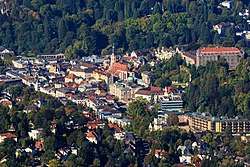 View of Baden-Baden from Mount Merkur. | |
 Coat of arms | |
Location of Baden-Baden 
| |
 Baden-Baden  Baden-Baden | |
| Coordinates: 48°45′46″N 08°14′27″E | |
| Country | Germany |
| State | Baden-Württemberg |
| Admin. region | Karlsruhe |
| District | Urban district |
| Government | |
| • Mayor | Margret Mergen (CDU) |
| Area | |
| • Total | 140.18 km2 (54.12 sq mi) |
| Elevation | 181 m (594 ft) |
| Population (2018-12-31)[1] | |
| • Total | 55,123 |
| • Density | 390/km2 (1,000/sq mi) |
| Time zone | CET/CEST (UTC+1/+2) |
| Postal codes | 76530–76534 |
| Dialling codes | 07221, 07223 |
| Vehicle registration | BAD |
| Website | baden-baden.de |
Name
The springs at Baden-Baden were known to the Romans as Aquae ("The Waters")[2] and Aurelia Aquensis ("Aurelia-of-the-Waters") after M. Aurelius Severus Alexander Augustus.[3]
In modern German, Baden is a noun meaning "bathing"[4] but Baden, the original name of the town, derives from an earlier plural form of Bad ("bath").[5] (The modern plural has become Bäder.)[6] As with the English placename "Bath", various other Badens are at hot springs throughout Central Europe. The current doubled name arose to distinguish it from the others,[5] particularly Baden near Vienna in Austria and Baden near Zürich in Switzerland. The name Baden-Baden is a reference to the Margraviate of Baden (1535–1771), a territory named after the town. Baden-Baden thus means the town of Baden in the territory of Baden. Baden-Baden got its formal name in 1931.[7]
Geography
Baden-Baden lies in a valley[8] of the Northern Black Forest in southwestern Germany.[9] The western districts lie within the Upper Rhine Plain. The highest mountain of Baden-Baden is the Badener Höhe (1,002.5 m above sea level (NHN)[10]), which is part of the Black Forest National Park. The old town lies on the side of a hill on the right bank of the Oos.[8] Since the 19th century, the principal resorts have been located on the other side of the river.[8] There are 29 natural springs in the area, varying in temperature from 46 to 67 °C (115 to 153 °F).[8] The water is rich in salt and flows from artesian wells 1,800 m (5,900 ft) under Florentine Hill[11] at a rate of 341 litres (90 gallons) per minute and is conveyed through pipes to the town's baths.[8]
History
Roman settlement at Baden-Baden has been dated as far back as the emperor Hadrian, but on dubious authority.[3] The known ruins of the Roman bath were rediscovered just below the New Castle in 1847[3] and date to the reign of Caracalla (AD 210s),[9] who visited the area to relieve his arthritic aches.[12] The facilities were used by the Roman garrison in Strasbourg.[9]
The town fell into ruin but its church was first constructed in the 7th century.[9] By 1112, it was the seat of the Margraviate of Baden.[9] The Lichtenthal Convent (Kloster Lichtenthal) was founded in 1254.[9] The margraves initially used Hohenbaden Castle (the Old Castle, Altes Schloss), whose ruins still occupy the summit above the town, but they completed and moved to the New Castle (Neues Schloss) in 1479.[3] Baden suffered severely during the Thirty Years' War, particularly at the hands of the French, who plundered it in 1643.[3] They returned to occupy the city in 1688 at the onset of the Nine Years' War, burning it to the ground the next year.[9] The margravine Sibylla rebuilt the New Castle in 1697, but the margrave Louis William removed his seat to Rastatt in 1706.[3] The Stiftskirche was rebuilt in 1753[9] and houses the tombs of several of the margraves.[3]
The town began its recovery in the late 18th century, serving as a refuge for émigrés from the French Revolution.[9] The town was frequented during the Second Congress of Rastatt in 1797–99 and became popular after the visit of the Prussian queen in the early 19th century.[9] She came for medicinal reasons, as the waters were recommended for gout, rheumatism, paralysis, neuralgia, skin disorders, and stones.[13] The Ducal government subsequently subsidized the resort's development.[3] The town became a meeting place for celebrities, who visited the hot springs and the town's other amenities: luxury hotels, the Spielbank Casino,[14] horse races, and the gardens of the Lichtentaler Allee. Guests included Queen Victoria, Wilhelm I, and Berlioz.[12] The pumproom (Trinkhalle) was completed in 1842.[8] The Grand Duchy's railway's mainline reached Baden in 1845. Reaching its zenith under Napoleon III in the 1850s and '60s, Baden became "Europe's summer capital".[9] With a population of around 10 000, the town's size could quadruple during the tourist season, with the French, British, Russians, and Americans all well represented.[8] (French tourism fell off following the Franco-Prussian War.)[13]
The theater was completed in 1861[8] and a Greek church with a gilt dome was erected on the Michaelsberg in 1863 to serve as the tomb of the teenage son of the prince of Moldavia Mihail Sturdza after he died during a family vacation.[15] A Russian Orthodox church was also subsequently erected.[13] The casino was closed for a time in the 1870s.[8]
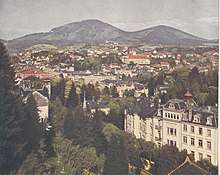
Just before the First World War, the town was receiving 70 000 visitors each year.[13]
During the Second World War, 3.1% of the houses in Baden-Baden were completely destroyed by bombs and 125 civilians were killed.[16] 5.77% of the houses were heavily damaged by bombs.[17] Lichtenthal, a residential area in the southwest of the town, was hit by bombs and Saint Bonifatius Church was severely damaged on 11 March 1943.[18] Balg, a residential area in the northeast of Baden-Baden, was hit by bombs on 17 December 1944. On 30 December 1944 one third of the buildings of Oos (i.e. about 300 houses), a residential area in the north of the town, was destroyed or heavily damaged by bombs and Saint Dionysius Church was severely damaged as well. On 2 January 1945 the railway station of Oos and various barracks on Schwarzwald Road were heavily damaged by bombs.[19] After World War II, Baden-Baden became the headquarters of the French occupation forces in Germany as well as of the Südwestfunk, one of Germany's large public broadcasting stations, which is now part of Südwestrundfunk. From 23–28 September 1981, the XIth Olympic Congress took place in Baden-Baden's Kurhaus. The Festspielhaus Baden-Baden, Germany's largest opera and concert house, opened in 1998.
CFB Baden-Soellingen, a military airfield built in the 1950s in the Upper Rhine Plain, 10 km (6 mi) west of downtown Baden-Baden, was converted into a civil airport in the 1990s. Karlsruhe/Baden-Baden Airport, or Baden Airpark is now the second-largest airport in Baden-Württemberg by number of passengers.[20]
In 1981 Baden-Baden hosted the Olympic Congress, which later has made the town awarded the designation Olympic town.
Climate
Climate in this area has mild differences between highs and lows, and there is precipitation year round. The Köppen Climate Classification subtype for this climate is "Cfb" (Marine West Coast Climate/Oceanic climate).[21]
| Climate data for Baden-Baden | |||||||||||||
|---|---|---|---|---|---|---|---|---|---|---|---|---|---|
| Month | Jan | Feb | Mar | Apr | May | Jun | Jul | Aug | Sep | Oct | Nov | Dec | Year |
| Average high °C (°F) | 4 (39) |
6 (42) |
11 (51) |
14 (57) |
19 (66) |
22 (71) |
24 (76) |
24 (76) |
21 (69) |
14 (57) |
8 (46) |
5 (41) |
14 (58) |
| Average low °C (°F) | −1 (30) |
−1 (30) |
2 (36) |
4 (39) |
8 (47) |
12 (54) |
14 (57) |
13 (56) |
11 (51) |
7 (44) |
2 (36) |
0 (32) |
6 (43) |
| Average precipitation days | 22 | 18 | 20 | 19 | 21 | 21 | 17 | 16 | 15 | 18 | 18 | 21 | 226 |
| Source: Weatherbase [22] | |||||||||||||
Lord Mayors
- 1907–1929: Reinhard Fieser
- 1929–1934: Hermann Elfner
- 1934–1945: Hans Schwedhelm (when he was not in office because of military service, mayor Kurt Bürkle was in office)
- April 1945-May 1945: Ludwig Schmitt
- May 1945-January 1946: Karl Beck
- January 1946-September 1946: Eddy Schacht
- 1946–1969: Ernst Schlapper (CDU) (1888-1976)
- 1969–1990: Walter Carlein (CDU) (1922-2011)
- 1990–1998: Ulrich Wendt (CDU)
- 1998–2006: Sigrun Lang (independent)
- 2006–2014: Wolfgang Gerstner (born 1955), (CDU)
- since June 2014: Margret Mergen (born 1961, (CDU)
Tourism
Baden-Baden is a German spa town.[23] The city offers many options for sports enthusiasts;[12] golf and tennis are both popular in the area.[12] Horse races take place each May, August and October at nearby Iffezheim.[12] The countryside is ideal for hiking and mountain climbing.[12] In the winter Baden-Baden is a skiing destination.[12] There is an 18-hole golf course in Fremersberg.[24]
Sights include:
- The Kurhaus, whose Kurgarten ("Spa Garden") hosts the annual Baden-Baden Summer Nights, featuring live classical music concerts[25]
- Casino
- Friedrichsbad
- Caracalla Spa
- Lichtentaler Allee park and gardens
- Staatliche Kunsthalle Baden-Baden (State Art Gallery)
- Museum Frieder Burda built by Richard Meier for one of Germany's most extensive collections of modern art[26]
- Fabergé Museum
- Museum der Kunst und Technik des 19. Jahrhunderts (Lichtentaler Allee 8), covering the technology of the 19th century
- Kunstmuseum Gehrke-Remund, which exhibits the work of Frida Kahlo
- Brahmshaus, Johannes Brahms's residence, which has been preserved as a museum
- Hohenbaden Castle or Old Castle, a ruin since the 16th century
- New Castle (Neues Schloss), the former residence of the margraves and grand dukes of Baden, now a historical museum[9]
- Festspielhaus Baden-Baden, the second-largest festival hall in Europe
- Ruins of Roman baths, excavated in 1847
- Stiftskirche, a church including the tombs of fourteen margraves of Baden
- Paradise (Paradies), an Italian-style Renaissance garden with many trick fountains
- Mount Merkur, including the Merkurbergbahn funicular railway and observation tower
- Fremersberg Tower
- Sturdza Chapel on the Michaelsberg, a neoclassical chapel with a gilded dome designed by Leo von Klenze which was erected over the tomb of prince Michel Sturdza's son
Transport
Road
The main road link is autobahn A5 between Freiburg and Frankfurt, which is 10 km away from the city.
There are two stations providing intercity bus services: one next to the main railway station and one at the airport.[27]
Railway
Baden-Baden has three stations, Baden-Baden station being the most important of them.
Air
Karlsruhe/Baden-Baden Airport is an airport located in Baden-Baden that also serves the city of Karlsruhe. It is the Baden-Württemberg second-largest airport after Stuttgart Airport, and the 18th-largest in Germany with 1,110,500 passengers as of 2016[28] and mostly serves low-cost and leisure flights.
Image gallery
 old town (Altstadt)
old town (Altstadt) Florentine Hill (Florentinerberg), with the New Castle (top right), the Caracalla Spa (lower right), and the Friedrichsbad (lower left)
Florentine Hill (Florentinerberg), with the New Castle (top right), the Caracalla Spa (lower right), and the Friedrichsbad (lower left)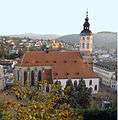 Baden-Baden's parish church (Stiftskirche)
Baden-Baden's parish church (Stiftskirche)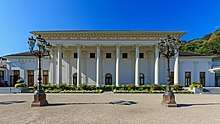 The Kurhaus and Casino
The Kurhaus and Casino The Trinkhalle
The Trinkhalle Brenner's Park Hotel
Brenner's Park Hotel The Russian Orthodox Church (Russische Kirche)
The Russian Orthodox Church (Russische Kirche)- The Friedrichsbad, New Castle, and Abbey School (Klosterschule vom Heiligen Grab)
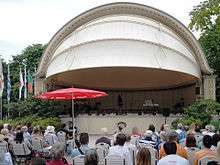 The Spa Shell, an open-air concert venue
The Spa Shell, an open-air concert venue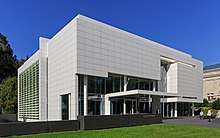 Museum Frieder Burda
Museum Frieder Burda- The Old Castle
Twin towns - sister cities
Baden-Baden is twinned with:[29]





Artistic depiction
Baden featured in Tolstoy's Anna Karenina (under an alias)[12] and Turgenev's Smoke. Dostoyevsky wrote The Gambler while compulsively gambling at the town's casino.[14][30]
The 1975 film The Romantic Englishwoman was filmed on location in Baden-Baden, featuring the Brenner's Park Hotel particularly prominently. The 1997 Bollywood movie Dil To Pagal Hai was also shot in the town.
Sons and daughters

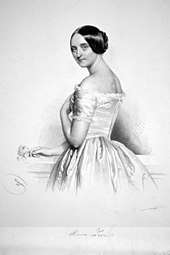

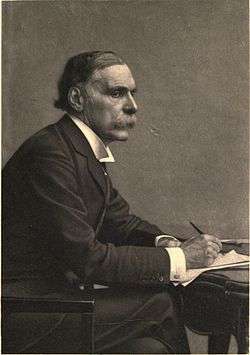
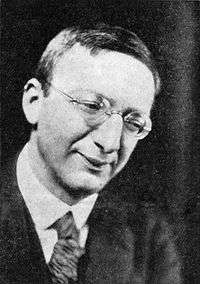
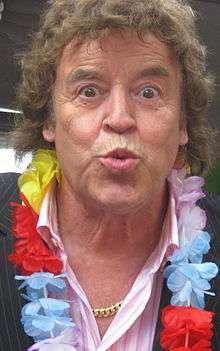
16th to 18th century
- Ferdinand Maximilian of Baden-Baden (1625–1669), father of the "Türkenlouis" Louis William, Margrave of Baden-Baden
- Friedrich, Freiherr von Zoller (1762–1821), Bavarian lieutenant-general who fought in the Napoleonic Wars
- Philip II, Margrave of Baden-Baden (1559–1588) was Margrave of Baden-Baden from 1571 to 1588
- William, Margrave of Baden-Baden (1593–1677), regent of Baden-Baden between 1621 and 1677.
19th century
- Alfred Döblin (1878–1957), German novelist, essayist and doctor
- Alfred Kühn (1885–1968), zoologist and geneticist
- Anna Zerr (1822–1881), German operatic soprano
- Colonel Francis Mahler (1826–1863), officer in the Union Army during the American Civil War
- Édouard Risler (1873–1929), French pianist
- Emil Kessler (1813–1867), entrepreneur, founder of the Maschinenfabrik Esslingen
- Erich Friedrich Schmidt (1897–1964), German and American-naturalized archaeologist
- Eugene Armbruster (1865–1943), New York City photographer, illustrator, writer, and historian
- Francis Pigou (1832–1916), Anglican priest
- Franz Carl Müller-Lyer (1857-1916), German psychologist and sociologist, the Müller-Lyer illusion is named after him
- Frederick Lindemann, 1st Viscount Cherwell (1886–1957), British physicist
- Joseph Vollmer (1871–1955), German automobile designer, engineer and pioneering tank designer
- Louis II, Prince of Monaco (1870–1949), Prince of Monaco from 1922 to 1949
- Max von Baden (1867–1929), last heir of the Grand Duchy of Baden, last chancellor of the Empire
- Paul Nikolaus Cossmann (1869–1942 in Theresienstadt), German journalist
- Sir George William Des Vœux (1834–1909), British colonial governor, Governor of Fiji (1880–1885), Governor of Newfoundland (1886–1887) and Governor of Hong Kong (1887–1891)
- Wilhelm Brückner (1884–1954), officer and chief adjutant of Adolf Hitler
- William Hespeler (1830–1921), German-Canadian businessman, immigration agent and a member of the Legislative Assembly of Manitoba
- Wolfgang Krull (1899–1971), mathematician
20th century
- Alexandra Kamp (born 1966), German model and actress, grew up in Baden-Baden.
- Andreas Heinecke (born 1955), social entrepreneur and creator of Dialogue in the Dark
- Ann-Marie MacDonald (born 1958), Canadian playwright, novelist, actress and broadcast host
- Antoinette Bower (born 1932), British-American actress
- Birgit Stauch (born 1961), German sculptor, works in bronzes, sculptures, sketches and portraits.
- Elmar Hörig (born 1949), radio and television presenter
- Felix Gilbert (1905–1991), German-American historian
- Florian Ballhaus (born 1965), German cinematographer
- Frank Moser (born 1976), German professional tennis player
- Fritz Suhren (1908–1950), SS Nazi concentration camp commandant executed for war crimes
- Heinz Bosl (1946–1975), German ballet dancer
- Jean-Marc Rochette (born 1956), French painter, illustrator and comics creator.
- Kai Whittaker (born 1985), German CDU politician, member of the Bundestag since 2013
- Leopold Gutterer (1902–1996), Nazi state secretary in the Reich Ministry of Public Enlightenment and Propaganda
- Magdalena Schnurr (born 1992), German ski jumper
- Marc Trillard (born 1955), French writer
- Marco Grimm (born 1972), football player, 334 pro appearances
- Reinhold Schneider (1903–1958), writer
- Robert HP Platz (born 1951), composer and conductor
- Rudolf Höss (1900–1947), Nazi, SS commandant of Auschwitz concentration camp, executed for war crimes
- Sabine von Maydell (born 1955), actress and author
- Stefan Anton Reck (born 1960), German orchestra conductor and painter
- Tobias A. Schliessler (born 1958), German cinematographer
- Tony Marshall (born 1938), pop and opera singer
See also
References
- "Bevölkerung nach Nationalität und Geschlecht am 31. Dezember 2018". Statistisches Landesamt Baden-Württemberg (in German). July 2019.
- Patricia Erfurt-Cooper; Malcolm Cooper (2009). Health and Wellness Tourism: Spas and Hot Springs. Channel View Publications. p. 67. ISBN 978-1-84541-111-4.
- EB (1878), p. 227.
- Messinger, Heinz; Türck, Gisela; Willmann, Helmut, eds. (1993), "bath·ing", Langenscheidt's Compact Dictionary: German
- Charnock, "Baden", Local Etymology, p. 23
- Messinger, Heinz; Türck, Gisela; Willmann, Helmut, eds. (1993), "Bad", Langenscheidt's Compact Dictionary: German
- Landesarchivdirektion Baden-Württemberg, ed. (1976). Das Land Baden-Württemberg. Amtliche Beschreibung nach Kreisen und Gemeinden. V. Regierungsbezirk Karlsruhe [The State of Baden-Württemberg. Official description of administrative districts and municipalities. Volume 5 Karlsruhe administrative district] (in German). Stuttgart: Kohlhammer. p. 12. ISBN 3-17-002542-2.
- EB (1878), p. 226.
- EB (2015).
- Map services of the Federal Agency for Nature Conservation
- "Caracalla-Therme". Frommer's. Retrieved 2009-05-23.
- "Introduction to Baden-Baden". Frommer's. Retrieved 15 May 2009..
- EB (1911).
- "Spielbank". Frommer's. Retrieved 2009-05-26.
- Winch (1967), Introducing Germany, p. 75
- Heinz Bardua (1975), Kommission für geschichtliche Landeskunde in Baden-Württemberg (ed.), "Kriegsschäden in Baden-Württemberg 1939–1945: Beiwort zur Karte 7,11" (PDF), Historischer Atlas von Baden-Württemberg (in German), Leonberg, p. 13, retrieved 2018-01-26, Format: PDF, KBytes: 2300
- Statistisches Jahrbuch deutscher Gemeinden, p. 378. Braunschweig 1952
- Catholic Parish of Saint Bonifatius: Wir über uns, p. 3. Baden-Baden 2002
- Dieter Baeuerle et al. Stadtführer Baden-Baden, p. 14. Baden-Baden 1994
- "ADV Monthly Traffic Report 12/2011" (PDF). Archived from the original (PDF) on 2012-08-13. Retrieved 2012-06-22.
- Climate Summary for Baden Baden
- "Weatherbase.com". Weatherbase. 2013. Retrieved on July 6, 2013.
- Bogue, David. Belgium and the Rhine. Oxford University. p. 102.
- "Active pursuits". Frommer's. Retrieved 2009-05-29.
- "Baden-Baden Summer Nights". Frommer's. Archived from the original on 2011-07-11. Retrieved 2009-05-28.
- "Sammlung Frieder Burda". Frommer's. Retrieved 2009-05-24.
- "Baden-Baden: Stations". Travelinho.com.
- Flughafenverband ADV. "Flughafenverband ADV – Unsere Flughäfen: Regionale Stärke, Globaler Anschluss". adv.aero.
- "Partnerstädte von Baden-Baden". baden-baden.de (in German). Baden-Baden. Retrieved 2019-11-27.
- "The Russians are Coming (Back)", CNN Traveller, Atlanta: CNN, retrieved 22 July 2009
Bibliography

- Chisholm, Hugh, ed. (1911), , Encyclopædia Britannica, 3 (11th ed.), Cambridge University Press, p. 184
- "Baden-Baden", Encyclopædia Britannica Online, 2015, retrieved 8 October 2015.
Further reading
- Charles Francis Coghlan, Jr. (1858). Beauties of Baden-Baden. London: F. Coghlan.
- Emmrich, Stuart (July 20, 2017). "36 Hours in Baden-Baden, Germany". The New York Times. ISSN 0362-4331.
External links
| Wikivoyage has a travel guide for Baden-Baden. |
| Wikimedia Commons has media related to Baden-Baden. |
- Official website
